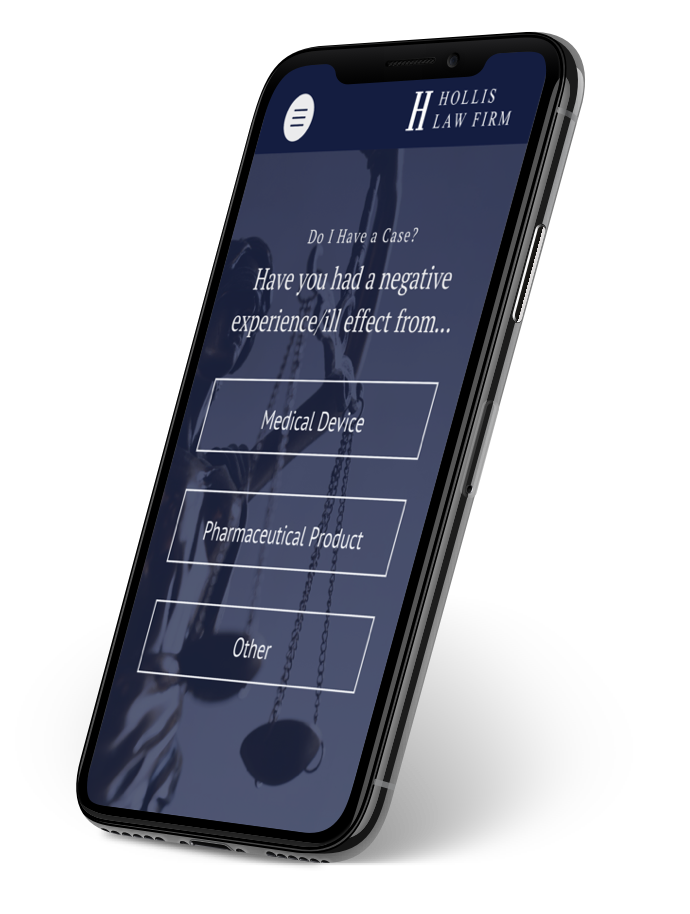Looking for representation in the Hernia Mesh lawsuit? Our experience, expertise, and resources make Hollis Law the ideal partner.
The FDA continues to quickly approve untested hernia mesh products, which benefits the medical device manufacturers and hurts the general public. When a product is then shown to be defective, severely injuring thousands nationwide, the FDA is slow to take any action. The manufacturers of hernia mesh know of the life-threatening complications their products can cause, but they don’t warn the public or surgeons. Educate yourself on the dangers of hernia mesh and warn those you know.
There are over 100,000 hernia meshes implanted every year in the United States. Many of the most dangerous hernia meshes remain on the market and have not been recalled by the FDA. Bowel obstructions and severe infections are common complications related to hernia mesh.
If you’ve been affected by this drug, contact us to learn how we can represent you in the Elmiron lawsuit.
Please call 1-800-701-3672 to speak to one of our trained hernia mesh team members. An attorney and a medical professional will look over your hernia mesh case and let you know what they believe the best course of action is for you. The Hollis Law Firm does not handle class actions. Each claim is an individual hernia mesh lawsuit. The specific facts of your case will determine if your hernia mesh lawsuit is compensable and to what amount. The Hollis Law Firm represents hernia mesh victims nationwide. All case evaluations and consultations are FREE, CONFIDENTIAL, and carry NO RISK or OBLIGATION. Call 1-800-701-3672 for a hernia mesh lawsuit evaluation. Follow our Hernia Mesh Lawyer Facebook page to stay up-to-date on the latest hernia mesh litigation updates.
Introduction
The Hollis Law Firm began its hernia mesh investigation approximately 3 years ago, and has since filed thousands of hernia mesh lawsuits against numerous hernia mesh manufacturers nationwide. Several types of consolidated actions regarding hernia mesh complications now exist, such as Multi-District Litigations (MDL), Multi-County Litigations (MCL), and class actions.
History of the Case
The Hollis Law Firm files hernia mesh lawsuits into MDLs, MCLs, class actions, and even as individual one-off lawsuits, depending on the unique facts of each hernia mesh claim. Typically there is strength in numbers, but sometimes a hernia mesh victim is best served in an individual lawsuit. Learn more about the various hernia mesh manufacturers and their defective hernia mesh products below. The hernia mesh links below will take you to even more information on a specific hernia mesh or manufacturer, and the status of the litigation. Our hernia mesh lawyers have now uncovered design defects in a large number of hernia mesh products currently on the market.
If you are considering having surgical mesh implanted for a hernia, please take the time to educate yourself of the dangers first. The hernia mesh litigations and investigations continue to develop and progress, make sure to book mark this page to stay up to date.
Injuries Related to Product
Hernia mesh is used to repair both ventral hernias and inguinal hernias. Various injuries and complications can occur depending on what part of the body the mesh is placed. A coated hernia mesh is also more likely to cause injuries such as infection than a non-coated hernia mesh. The following is a list of the array of complications our hernia mesh lawyers have observed:
- Infection, including sepsis. An infected hernia mesh almost always requires removal.
- Adhesions form to connect the bowel to the hernia mesh. Adhesions frequently form when ventral hernias are repaired with a coated mesh.
- Bowel Obstruction caused by adhesion formation. Evidenced by a change in bowel habits or the inability to defecate.
- Abdominal Pain is a sign of possible adhesion formation, a bowel obstruction, infection, or nerve damage.
- Rashes are commonly observed in association with hernia meshes such as the C-Qur V-Patch and Ventralex ST.
- Leg, Groin, and Testicular Pain are all common to inguinal hernias repaired with mesh. This pain can be debilitating.
- Pain with Sex (Dyspareunia) caused from the mesh used to repair an inguinal hernia attaching to the spermatic cord.
- Testicle Removal may be necessary if the mesh erodes far enough into the spermatic cord.
- Diarrhea can be an early symptom of the mesh attaching to the bowel.
- Constipation can be a sign of a bowel obstruction. You should consult a doctor if your constipation persist for several days.
- Nausea can be an additional sign of adhesions to the bowel and stomach.
- Seroma is a fluid capsule surrounding the mesh. Seromas can be present with and without infection.
- Fistula. An abnormal tunnel between two structures. Our attorneys observe many fistulas connecting to the bowel, which are associated with infections.
- Dental Problems. Our lawyers have observed a large number of clients who have lost their teeth after a hernia mesh infection.
- Autoimmune Disorders. An alarming number of our clients have developed autoimmune disorders after being implanted with a pelvic or hernia mesh.
- Neurological Changes. Several of our clients that have been implanted with the same type of mesh have been diagnosed with unexplained neurological changes on a CT scan.
- Severe Headache. Typically a sign of a larger problem, such as an infection.
- Fever. Associated with both an autoimmune response to the mesh and infection.
- Renal Failure has been observed in those implanted with large coated meshes. The coatings are absorbable and put a great deal of strain on the kidneys.
- Liver Abnormalities have also been documented in those implanted with coated hernia meshes. The liver is also responsible for cleansing the body.
- Joint Aches and Pain can be caused by increased systemic inflammation due to infection and an autoimmune reaction to the mesh.
- Abnormal Sweating can be related to an autoimmune response or to an infection.
- Meshoma is the migration, contracture, or bunching-up of an artificial mesh. Meshomas become hard, tumor-like bodies.
Additional Literature
2017
November 2017: Surveillance of Surgical Meshes in Ventral Hernias and Unpredictability of Their History.
The authors explain that “mesh-related visceral complications are hardly considered, although they have much more significant adverse effects on the patient, when compared with common complications following abdominal hernia repair, and they require a challenging surgery in the majority of cases.” The authors note that “mesh manufacturers claim their meshes are visceral compatible, mostly on the basis of the results of animal studies, but it is not true. No material is inert, even the supposed viscera-friendly meshes.” The authors opine that “tissue reactions occur as a result of a chemical process related to the degradation of coated meshes.”
September 2017: The Importance of Registries in the Postmarketing Surveillance of Surgical Meshes.
The studies objective was to assess the role of registries in the postmarketing surveillance of surgical meshes, because surgical meshes do not require premarket clearance by clinical studies. The authors concluded that “registries tend to be more suitable for long-term evaluation of surgical meshes for all patients operated on with this medical device… therefore, based on the new marketing authorization procedures, before surgical meshes are first placed on the market in the future, it is likely that [randomized controlled trials] will be carried out, whereas registry studies will be used to collect clinical data for postmarketing surveillance of surgical meshes.”
June 2017: In Vitro Study on the Deterioration of Polypropylene Hernia Repair Meshes.
The authors investigated how hernia meshes change once they have been implanted. The authors note that “oxidative stress at the site of implantation causes polymeric implants to lose their structural and mechanical integrity; crystallinity and molecular weight may also change. This can result in the mechanical stiffening and/or shrinkage of the mesh, which may ultimately lead to the development of postoperative chronic pain.” The authors conclude that their “results are also in agreement with those obtained for the explanted PP hernia repair meshes that also demonstrated cracks, extrusion lines and holes on the surface.”
2016
632 patients were studied for two years after being implanted with hernia mesh. 31% experienced complications within just two years. Complications included cellulitis, necrosis, nonhealing wound, seroma, hematoma, dehiscence, and fistula. Patients with a preoperative MRSA+ infection from any site (urine, blood, surgical site), might be at an elevated risk for hernia mesh complications.
August 2016: Oral, Intestinal, and Skin Bacteria in Ventral Hernia Mesh Implants.
36 patients with failed hernia mesh were studied. All participants were found to have gingivitis and 33% had infected gums and teeth. Oral bacteria was discovered on 43% of explanted hernia mesh. The study discusses the difficulty in knowing the real rate of hernia mesh infections, due to lack of standardized criteria to define infection, lack of follow-up exams, and lack of intervention when complications arise. It notes that hernia mesh infection is the most common reason for mesh removal.
June 2016: Sepramesh and Postoperative Peritoneal Adhesions in a Rat Model.
The study notes that “postoperative peritoneal adhesions occurred at the extremities of the mesh, where there was close contact between the polypropylene and viscera, or where the fixation suture was placed.”
2015
August 2015: Degradation of Polypropylene in Vivo: A Microscopic Analysis of Meshes Explanted From Patients.
164 explanted polypropylene meshes were reviewed. 162 of the explants exhibited signs of degradation. The only two hernia meshes to not exhibit signs of degradation had only been implanted for 3 and 10 months. The authors note that “polypropylene degradation is likely mediated by the foreign body reaction, which is ongoing until the device is removed. Our observations of adherent macrophages on the polypropylene surface are consistent with the previous studies reporting chronic inflammation in explanted polypropylene mesh several years after implantation.” The authors also explain the clinical importance “of degradation is the potential for bacterial colonization of the fissures within the degraded material. It is known that irregularities of polymer surface promote bacterial adherence.”
768 patients underwent hernia repair. 10% experienced a hernia mesh infection. 33% of patients with a preoperative MRSA+ infection experienced a hernia mesh infection.
2014e
637 hernia mesh repairs and 1145 suture repairs were compared. Hernia mesh repair was associated with a slightly lower rate of recurrence, but a higher rate of severe complications. The authors admit that “further high-quality studies are necessary to determine whether suture or mesh repair leads to improved outcomes for primary ventral hernias.”
2013
November 2013: Coated Meshes for Hernia Repair Provide Comparable Intraperitoneal Adhesion Prevention.
Uncoated polypropylene was compared to various types of coated polypropylene placed intraperitonally via laparoscopic procedure. The uncoated polypropylene hernia mesh resulted in significantly more adhesions.
The study notes that “In laparoscopic incisional hernia repair, direct contact between the prosthesis and the abdominal viscera is inevitable, which may lead to an inflammatory reaction resulting in abdominal adhesion formation.” The authors advise additional research is necessary, and to be wary of short-term experimental results on laparoscopically placed hernia mesh.
October 2013: Intra Peritoneal Polypropylene Mesh and Newer Meshes in Ventral Hernia Repair: What EBM Says?
The authors are concerned about using polypropylene mesh (PPM) for laparoscopic hernia repair. They question if paying 15-20 times more for a composite mesh is worth it. The study notes “Complications of intraperitoneal PPM (adhesions, infection, intestinal fistulization, sinus formation, seroma and recurrence) can occur with the newer mesh also. There is no statistically significant difference in the incidence of these complications between these meshes.”
2012
July 2012: Post-Implantation Alterations of Polypropylene in the Human.
The author concludes that polypropylene “alters in vivo after implantation. It undergoes various processes that lead to degradation, including oxidation, cross-linking, depolymerization and embrittlement. These processes result in various degrees of degradation, and the loss of mechanical and physical properties. PP mesh is not inert.”
The study notes that polypropylene “is unsuitable for intra-abdominal placement because of its tendency to induce bowel adhesions.”
2011
August 2011: Complications of Mesh Devices for Intraperitoneal Umbilical Hernia Repair: A Word of Caution.
The surgeons note experiencing serious complications in several patients implanted with a composite mesh. Injuries included small bowel resections and mesh removal. The study notes “We think that, if preperitoneal deployment of such mesh devices is possible, this should be the preferred position, notwithstanding the fact that these meshes have a dual layer. There is a complete lack of convincing data on these mesh devices in the medical literature. No long-term data have been published, and, for three of the four mesh devices available, no publications on their use in humans were found.”
July 2011: Mesh Infection in Ventral Incisional Hernia Repair: Incidence, Contributing Factors, and Treatment.
The study discusses the need for a better identification, classification and reporting systems for hernia mesh infections. It notes part of the difficulty is that hernia mesh implants have a tendency to remain dormant for long periods of time. It can take years before a hernia mesh infection is identified.
2010-2009
January 2010: Oral Biofilms: Emerging Concepts in Microbial Ecology.
The overall health and biology of an individual is closely linked to which oral biofilms develop.
June 2009: The Problem of Mesh Shrinkage in Laparoscopic Incisional Hernia Repair.
Laparoscopic hernia repair requires expanding the abdomen with approximately 3 liters of gas. The surface area of the abdominal wall is stretched by about 80% during laparoscopic repair. Surgeons must anticipate significant mesh shrinkage in laparoscopic hernia repair. Mesh shrinkage remains one of the unsolved problems of laparoscopic incisional hernia repair.
Do I Have a Case?
Give us a few details about your concerns and our case tool will help you get the answers you need.










